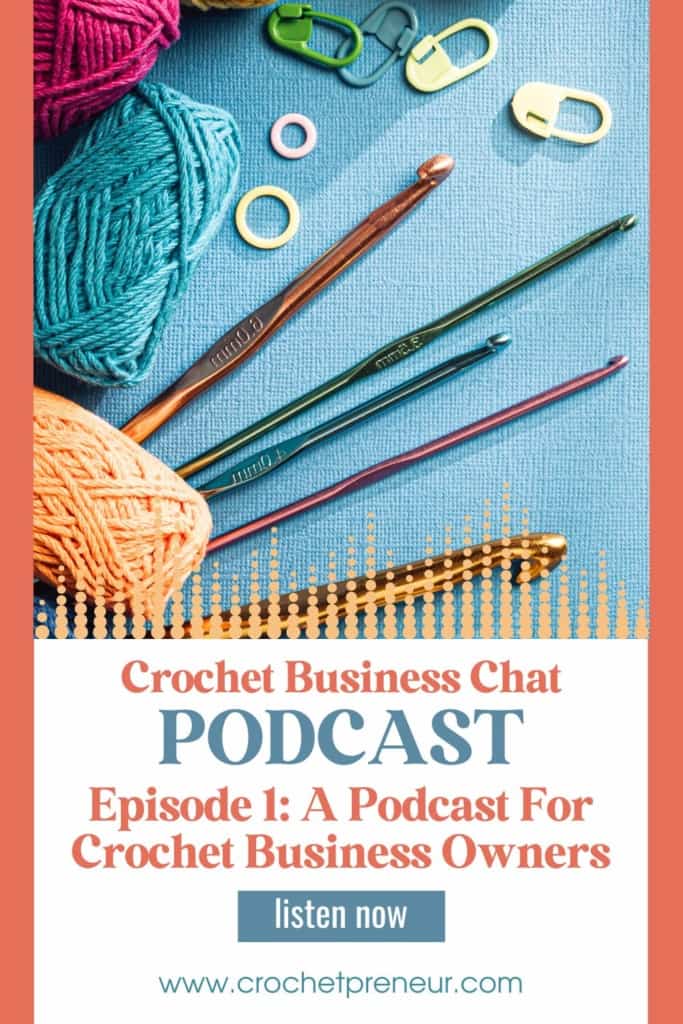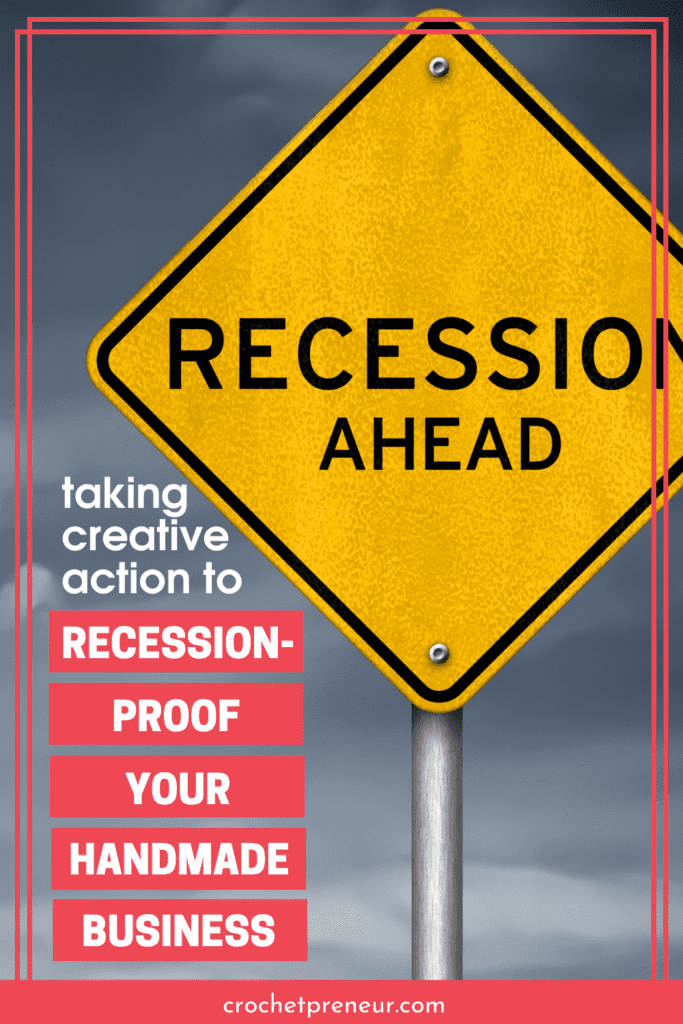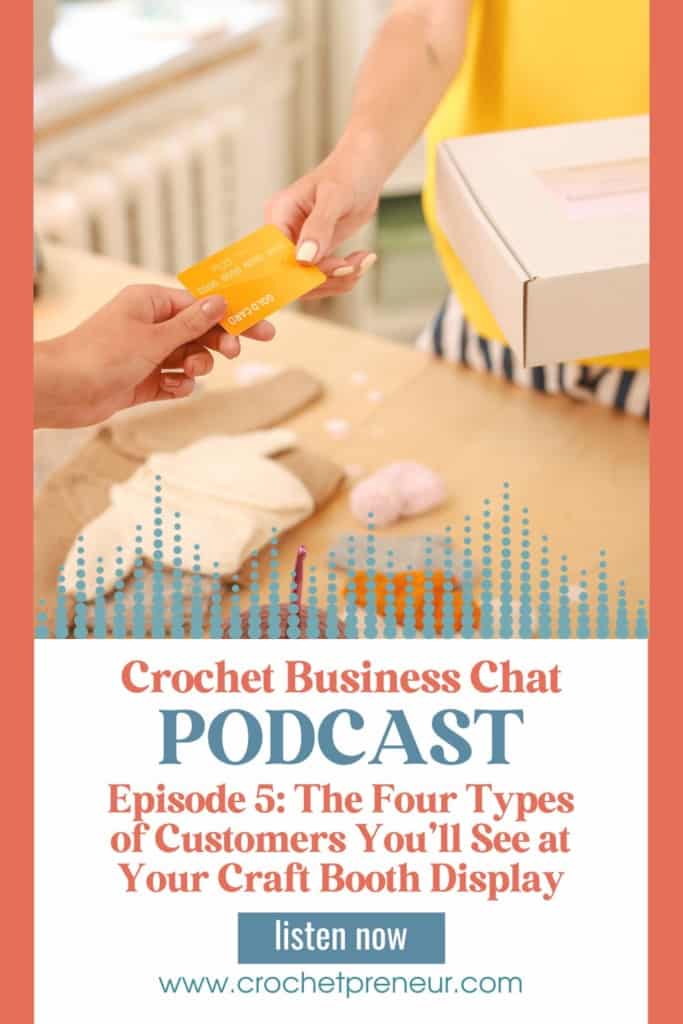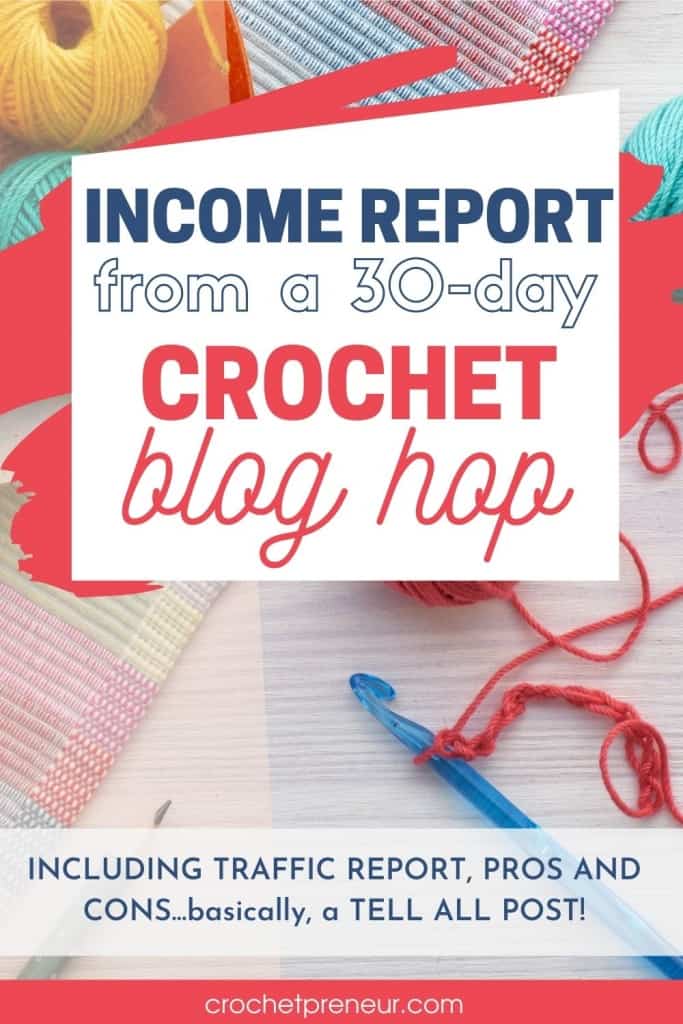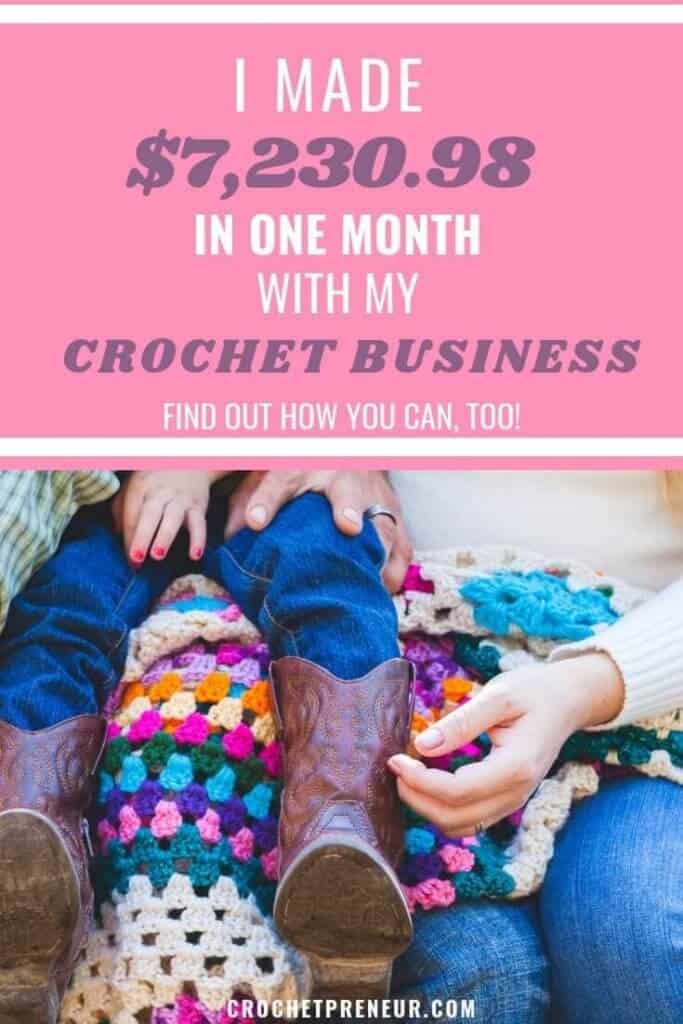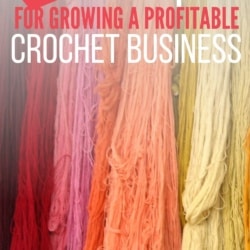Have you ever thought to yourself, “I wish I could get paid to crochet all day?” Running a crochet business does let you make money doing what you love. But there’s a little more to it than just crocheting all day. To take yourself from hobbypreneur to Crochet CEO, you need a strategy. You need to think about profitability, customer service, sales, marketing, and managing resources. All of this sounds complex. But with purpose, determination and consistency, it is totally doable! Let me share 10 principles to help you build a successful handmade business.
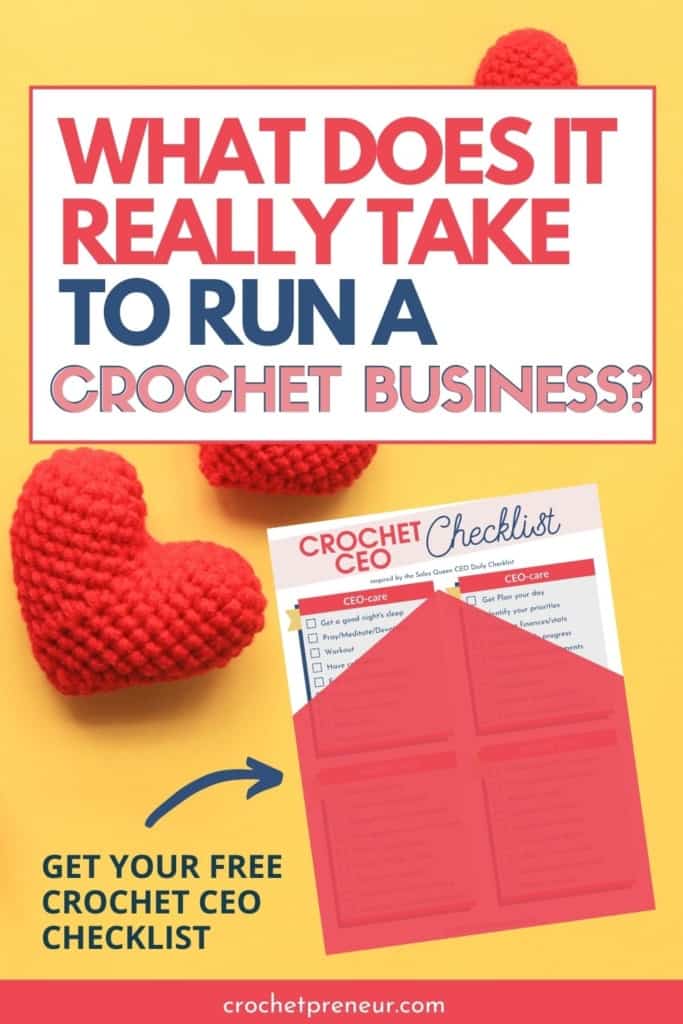
What Does it Really Take to Run a Crochet Business?
[00:00:00] Good morning. It is Monday morning Crochet Business Chat. Thank you for joining us. I am Pam Grice, your Crochet Business Coach and the Crochetpreneur. I’m on a mission to help 100,000 women find financial freedom through crochet. And I’m so glad that you’ve joined us today. If you are looking for crochet business tips, help, encouragement, tough love, go ahead and click that subscribe button below so you get all of my videos, etc. Click the notification bell so you don’t miss anything. And be sure to like this video so that YouTube tells all the other folks they need to come watch it as well. We’re going to talk today about do you really want to have a crochet business?
Transcript: What Do You Need to Know When Starting a Crochet Business?
[00:00:43] Yeah. So how about we get into that. I’m so happy you’re here. Let me see. Say hello. If you’re watching, say hello. Sorry. My husband is on his way out. His truck is noisy. Do you have a crochet business? Do you want to start a crochet business? How long have you had a crochet business? Is it everything you thought it would be? Let’s talk about—from my perspective, other people have different perspectives—from my perspective the 10 principles of running a crochet business. I want to take a look at them so that you can then ask the question, “Is this what I want? Is this what I want to do?”
The Hierarchy of Growing a Handmade Business
[00:01:27] So I’m going to share. Hi, Lisa. I’m going to share some images with you because I prefer to have pictures. It just makes it easier for me. So there we go. Do you really want a crochet business? Here is how I see kind of the stages. There may be others. There may be more but this is how I look at it, just from my own perspective. This is like Maslow’s hierarchy of needs. This is the hierarchy of growing a crochet business or a handmade business.

[00:02:06] So you see down here, this is the hobbypreneur. This person, for fun, makes what he or she wants to make and tries to find people to buy those things, and takes that money, and turns around to fund their yarn habit, basically. So this is a person who makes for yarn, basically. This person doesn’t really have a strategy, doesn’t have an ideal customer, just makes whatever they want and looks for buyers. Oh. These two slides are supposed to be switched. See that?
[00:02:50] All right. This is the for-profit business owner. So this person has made a transition into saying, “I want to make this into a legitimate business and I want to make some profits.” So I’m going to start looking at what’s my niche? Who’s my target customer? What does my target customer need? And start making products that will meet those needs and be more profitable. So I think about profit optimization. How much time am I spending making these things? Am I pricing these things properly? all that kind of stuff.
[00:03:27] And then when we take a look at Crochet CEO, that is someone who is now in the place where they’re looking to scale their business. They have a mindset of a CEO of, “I want to create a business that creates financial stability. I have goals for my business. I’m wanting to continue to grow.” I might even be wanting to bring on a team and like really stepping into that role of CEO business owner. So it’s just a slight shift from profit based business owner to CEO, but CEO is more about scaling and how do I continue to grow this thing–ultimately, if you want, about how do I build an empire out of this business that I love. Now we’re back to this one.
[00:04:19] Basically these are my people. These are the people that I’m speaking to. Hobbypreneurs typically don’t need me. I do have some hobbypreneurs in my program. But they’re not basically who I’m speaking to. I’m speaking to people who want strategy, who want to save time and save heartache basically by sharing the things that I’ve seen work for other crochet business owners, the things that have worked for me, basic business strategies that will get you profitable and get you growing.
10 Principles of Running a Crochet Business
[00:04:24] So these are my 10 principles for growing a profitable Crochet Business. So if you’re one of those people, you’re wanting to become a profitable business owner or a Crochet CEO, you’re in the right place right now, as we talk about the 10 principles for growing a crochet business.
Principle 1: Businesses exist to make money and to grow.
[00:05:16] So principle one. Principle one is businesses exist to make money and to grow. If you are in this business to be famous, to have a lot of people fawn all over you, to get likes, to–what else?–get people praising how pretty the things are you make, that is a hobbypreneur mindset. That is not a business focused mindset. So businesses focus on profit building activities, so activities that have a return on your investment. Businesses focus on, “Is this making me money? Is this a valuable thing for me to be spending my time with?” That kind of stuff.
[00:06:06] So this is just an important thing to recognize and check in with yourself throughout the day of, “Am I spending my time on income producing activities or am I spending my time on vanity metrics, vanity comment, those kinds of things, likes, follows, comments?” We all need engagement, and there’s a place for that, but it’s not a priority on the list of profit-making activities. Okay. If you have any questions about that, feel free to put them in the comments and I’ll come back and answer those later.
Principle 2: Your business needs to become a magnet for your ideal customer.
[00:06:45] Next principle. Number two, your business needs to become a magnet for your ideal customer. So your branding, your messaging, your products, and the problems they solve all need to be focused on the ideal customer. So the more they’re focused on me, and what I want to do, and what I want to make, and how I want to do things, the less I’m going to attract people who are going to actually spend money. This is that mindset shift of, “It’s not all about me. My customers feel like it’s all about them.” So I need to focus on creating a brand and a product line that attracts the people who are going to be spending money in my business.
Principle 3: If you don’t show up, neither will your people.
[00:07:35] Next principle three, if you don’t show up, neither will your people. So I have a problem. I’m just going to own it. I have a problem with consistency. I don’t always show up in my business the way that I would hope that I would. And so I notice my engagement goes down. My sales go down. All of that. When I don’t show up, my people don’t show up either. And it’s not because they don’t care about what I have to offer. It’s that I’m not putting my offer in front of them on a consistent basis. So you need to show up in your business if you’re expecting your customers to show up. Principle three.
Principle 4: You won’t sell without selling.
[00:08:18] Next, principle four. You won’t sell without selling. So many people, when I say, “Why are you stuck in your crochet business?” “I don’t want to be salesy. I don’t like selling.” Hey, you’re in the wrong business if you don’t like selling. I’m sorry, but your business is here to make money. And if you do not sell, people will not buy.
[00:08:42] Now, there are ways of selling in a way that is not salesy, because if you believe in your product and it’s going to be beneficial for your customers, it’s easy to say, “Oh my gosh, you have this problem. I have this thing that will solve your problem. You really need it.” So that’s not about. Being salesy. That’s just about selling what you have, the solution you have to your customer’s problem. So you can sell without being salesy, but you can’t sell without selling. Seems to make sense, but a lot of people refuse to even sell within their business and then they complain that they’re not making money. So if you’re not willing to sell, maybe you’re going into the wrong business. Oops. Hi, that was me.
Principle 5: Your purpose must be stronger than your fear.
[00:09:30] All right. Principle five is your purpose–your why–must be stronger than your fear. So I was talking to some people last weekend while I was at Interweave Yarn Fest. We were talking about why some people make it and some people don’t–why some people use life as an excuse for not moving their business forward, when other people with similar struggles, similar roadblocks push through those things and build their business anyway. Even though life happens, even though there’s illness, even though there’s kids, even though there’s another job, even they’re still doing it. So what is the difference?
[00:10:15] A lot of times that difference is who’s hungrier and also who’s willing to have the courage to move forward. So often when we are presented with a roadblock, we see it as an out, like, “Oh my gosh, there’s a benefit to this roadblock because now I don’t have to face my fears. I don’t have to be out there when I don’t want to be out there. I don’t have to sell when I don’t want to sell because this thing happened.” And so we use that as an excuse to not face our fears. The people who grow a profitable business are willing to face those fears and their purpose. They see, “I can’t reach my goals. I can’t fulfill my purpose. I can’t fulfill my why I’m in business if I don’t overcome those fears.”
[00:11:12] So it’s definitely a personality trait that can be fostered and nurtured. If you’re a kind of person that gives into fear often, then there are things you can do to nurture your courage. And being in a community is part of that. Part of principle five is the life you want is on the other side of action, so recognizing that, “I will stay where I’m at if I don’t take action. But if I want to get where I want to get, if I really want to, I will face the fear and I will take action anyway.” So it’s about doing it scared.
Principle 6: There is magic in the strategy.
[00:10:37] Principle six, there is magic in the strategy. So often people, like I said with hobbypreneurs, they don’t have a strategy. And the thing with a strategy is a strategy is what will bring you more customers, turn those customers into repeat customers, and get you more money. Which again, we’re not hyper-focused on the money, but we are focused on … We have to create profit and growth in order to actually have a business. So it’s not about becoming enslaved to the money. It’s about using the money and creating a strategy.
[00:12:37] Or even if you’re a kind of person like me, who loves strategy, seeing it as a game of, “How can I work this strategy in order to get the outcome that I want?” No matter what the other players in the game are doing, I’m going to create my strategy in order to get more money to create the life I love, but also to create more impact. And we’ll talk about that in a little bit.
Principle 7: People don’t care what you have to say until they know how much you care about them.
[00:13:04] Principle seven. People don’t care what you have to say until they know how much you care about them. So basically, this is the principle of people are selfish. And I don’t mean that in a judgmental way. I’m just saying, this is our nature. As human beings, we are constantly saying, “Is this for me? What’s in it for me? Is this valuable to me?” And as you are marketing your business, if you are focused only on yourself or only on your products and not on the customer, the customer is not going to listen to you.
[00:13:45 You need to go into all of your marketing in a way that speaks directly to the customer so that you’re speaking their language, you’re attracting them to your business, and you’re telling them what the benefits of your products are. Whether you’re a pattern designer, a service provider, a product seller, you are in the business of service. And focusing on how I am serving them with my products.
[00:14:11] What pain points am I easing? If you’re not easing any pain points, people are not going to give you money. That is a basic law of human nature. So people give money to ease pain. And that pain may be, “I don’t feel cute today.” Or that pain may be, “I don’t have a present for the baby shower that’s coming up.” So the pain doesn’t have to be some huge existential pain. It can simply be, “I have a need and I need something to resolve that need. So I don’t have to stress about this thing, or I don’t have to think about that thing, or it’s just going to make me feel better.” So your product serves them by making them feel better. And you need to articulate how your product will make them feel better so that they can then see the value in that and spend money
Principle 8: Give, then ask.
[00:15:02] And principle eight, give then ask. This is about … We’ve all seen the Facebook pages where you go to someone’s page and every single post is a sales post. It’s an ask. Every single post is saying, “I have this for sale. I have that for sale. I have this for sale,” and they’re basically asking for money but they’re not, a, articulating the benefits and they’re not, b, giving anything else to these customers of value.
[00:15:35] So I really recommend, give three times before you ask anything. So give three things of value. They don’t have to be products. Give three things of value before you ask for a sale. So that could be, I post a quote that makes you feel empowered today. I post an infographic that shows you how to style your wardrobe today or I post a meme that makes you laugh. So you’re giving value. I post a link to someone else’s blog post that is sharing information that I know you’re looking for because I know my ideal customer. I know what they’re looking for. I can give them value, even if it’s not something I’ve created.
[00:16:19] So give, give, give. And then you ask. And then you say, “Oh, by the way, I know you have this need and I created this thing for you. If you would like that, if you would like to feel this way after you purchase it, here’s the link.” In that way, you’re nurturing your followers. You’re attracting followers before you give a sale or before you ask for the sale.
Principle 9: Believe that you can make money out of thin air and have a strategy to do that.
[00:16:45] Next this is the tenet for entrepreneurship. You have to believe that you can make money out of thin air and have a strategy to do that. When you are an entrepreneur, making money is your job. And not just making money to pay the bills but making money because this is what you do. This is what you do as a business owner.
[00:17:10] And as a business owner who doesn’t have a boss perhaps, unless you work an outside job, you have a boss and you have some income coming in. But if you’re just, this is what you do, you have your crochet business, your job is to pay the bills, help with family finances, whatever it is that you’re using the money for. And sometimes things happen where you say, “Oh my gosh, I have this bill to pay,” whether it’s a medical bill, or a car repair bill, or the basement flooded. Something’s happening and you say, “I have to make money.”
[00:17:47] When you run your business strategically, you can then say, I have to make money. I know how to make money out of thin air. I’m going to do this.” It could be, “I’m going to have a sale.” It could be, “I’m going to send an email to my list. I’m going to create a new tripwire. I’m going to host a flash crochet- a-long,” All of these things.
[00:18:08] You could just sit down and brain dump all the ways, that if you had to make $100 today, how would you do that? If you had to make $1,000 today, how would you do that? And put them on a list so that when that time comes, because it will come, you can look at the list and say, “Okay, I’m going to do that. I’m going to send an email to my list with a,” whatever you have to offer. Either it’s a coupon code, which is not my favorite, or a new product, or a new service, something that will help them that you’ll get the people on your list to purchase. And you’ve made your $100, you’ve made your $1,000, whatever it is.
[00:18:47] As you grow your business, you can help strategize more and more of these kinds of ideas to make the money that you need when it comes. Because as an entrepreneur, it will come and there’s going to be times when you say, “Oh my gosh, I need $500.” And you can rest assured that you know how to make that happen.
Principle 10: Paint like a rich person.
[00:19:09] All right. The last one, paint like a rich person. I took oil classes once and I didn’t have a lot of money. And so when I was putting paint on my palette, I put a little dab here and a little dab there and a little dab there. And my instructor came around and said, “The number one rule of painting is paint like a rich person.” And she came over with a caulking gun of white oil paint and she squeezed it onto my palette. And she put big, huge blobs of all of the colors on my palette and said, “You will not make a beautiful painting unless you paint like a rich person and use all of the paint you need.”
[00:19:52] And this is a principle that I have brought into my business as well. And it’s not about, “You need to go spend a bunch of money to build your business, but you need to not be fearful to invest in your business or to use the tools you need to help in your business, to invest in people, to help in your business. It’s about being wise with your finances and also being wise when you’re using resources in your business.
[00:20:26] Sometimes we say, “Oh, I’m going to use the free option,” but that free option then makes it so that you have to spend four or five times more time getting what you need to get done than you would if you were paying $10 a month for the paid option. So you’re spending five hours of your time on something that you could be spending $10 on. So it’s about making those wise decisions and not being fearful to invest in the resources you need to grow your business. Paint like a rich person, right? Use all of the resources that you have, and then don’t be afraid to invest in what you need to create what you want to create. You don’t want to create something small and thin. Like when you’re painting, you want texture, you want depth. You want the same thing in your business.
[00:21:24] Stop focusing on the money. So when we are obsessed with the money … So I know I’ve talked a lot about the money before, but I’m talking about the money from a very empowered place of I’m creating the finances to have the impact that I want to have or to do the things I want to do. But when we focus on the money from a place of fear of, “I don’t have enough money. I’m afraid I’m not going to have enough money. I have to put more sales posts out there because I gotta make the money,” or, “I can’t invest the money in my business because I gotta make the money,” basically the money is repelled because we start making decisions on our business that don’t actually make the money. They repel the money or they make it harder to make money.
[00:22:09] So again, paint like a rich person. Stop focusing on the money. Focus on the empowerment. Focus on the belief that you can make money out of thin air. Focus on, “This is easy. This is not hard. It doesn’t have to be hard.” And then really step into that place of, “I am a business owner. I am wise. I make great decisions.” You see I’m saying all of these affirmations because this is what I want you to be saying to yourself.
Do You Want to Start a Crochet Business?
[00:22:35] And so do you want to start a crochet business? You can start a crochet business without thinking about all of these things. Sure. But will you grow? Will you create the life that you want to create if you don’t put these 10 principles in place? I don’t think so. Is this the only way to think about business? Absolutely not. Other people think other ways about business. However, this is the way that I’ve seen work for hundreds of handmade sellers. So we’ve had over a thousand students in CBA. Some of them implement their strategies. Some of them don’t. The ones who do, I see them grow. I see them making the money that they want. I see them scaling their businesses. And that’s what I want for you if that’s what you want.
[00:23:20] Again, when we go back to here, you have to decide which person you are. If you want to stay a hobbypreneur, that’s fine. That’s fine. I’ll tell you what happened this past weekend. I told you I was at Interweave. Someone came up to me and she was like, “Hi, I’m in CBA. I just wanted to come and say thank you so much.” She was like, “I walked through those first few lessons or the first module. And at the end, I was like, ‘I don’t want to be a business owner. I just want to do this for fun. I don’t want to focus on the strategies. I just want to focus on doing what I want to do,’ and I would never have realized it if I hadn’t taken the class and asked these deeper questions.” So she’s like, “Sure. I invested money in this business course. But the value I got out of it was I got my time back because I didn’t waste time building a business I didn’t want.” So that was really valuable for her. And she was really grateful.
[00:24:25] And so I think that’s what spurred me to make this video in the first place is to help you understand. Do you really want to be a business owner or do you want to just be a hobbypreneur Do you want to just make a few dollars here and there buy yarn, make pretty things and be done with it? If that’s what you want, that’s great. But if you want something more than that, if you want to have a business, if you want to say, “I’m a designer. I’m an artist. I’m an artisan. I’m a product seller. I’m a service provider for crochet business owners. I’m a tech editor. I’m a virtual assistant,” whatever you want to be. If you want to scale a business and make the money that you want, then you’re in these two places. And I really want to encourage you to put those principles into action. Okay.
Don’t Miss Crochet Business Summit 2022!
[00:25:10] And to help you do that, for those of you who haven’t already registered–I know there’s been a bunch of you who have–but if you hadn’t already heard about the Crochet Business Summit … If you’re watching this on replay and we’re in June, this doesn’t relate. But you can go to this website anyway, which is CrochetBusinessSummit.com and you can get on the waitlist for next year. But if we are before May 16th, head on over to CrochetBusinessSummit.com. Register for our free summit. I will be sharing some free mini classes, just like this one, throughout the next couple of weeks before the Summit starts.
[00:25:47] And then once the Summit starts, we’re going to have 24 presentations on both … I’m going to put myself back on screen. Hang on a second. Hi, we’re going to have 24 presentations about both increasing the income streams, scaling your business, and about self care, and preserving your love for the business, and preserving your relationships while being a business owner, because we can get a little obsessive with our businesses and let things slide. So we’re going to take a look at both of those things–increasing income, also increasing self care and your enjoyment of your business and your life. So we’re going to combine those two things in these 24 presentations. And again, it’s free. Go ahead and sign up at CrochetBusinessSummit.com.
[00:26:38] And then we’re going to go look at … I’ve been talking a lot. I’m going to go look at … Linda said she’s a hobbypreneur, “and I’m taking a year to regroup.” Gotcha. “My fear, ‘Will my people be there when I’m ready?’ has been real this week.” You’ll get there. You’re going to get there, Laura.
[00:26:59] Katie said, “Paint like a rich person.” She and I had this conversation last weekend. Yes, “Don’t be penny wise and time foolish.” That is a really good saying that I’ve never heard before. So thank you for sharing that. Yes, exactly. The more you scrimp on your funds, the more you … Like you have to trade time for money somewhere. And so being wise about how and where you do that.
Conclusion
[00:27:23] Okay. So that’s what I had for you today. If you’re in the Crochet Business Summit Facebook group, there’s lots of questions in there for you to answer, lots of fun new friends to make. So I hope you’ll spend some time in there today. And I’m going to go work on some behind-the-scenes things, so we can bring you an amazing event. And thank you for being here. Again, be sure to subscribe for more crochet business tips. And if the summit is already over, go ahead and get on our wait list for next year. All right. Thanks, everyone. I will talk to you later.
[And as a bonus, if you’re really serious about becoming a Crochet CEO, use the form below to sign up for my mailing list. I’ll send you my free Crochet CEO Checklist that can help you get started on your journey!]




